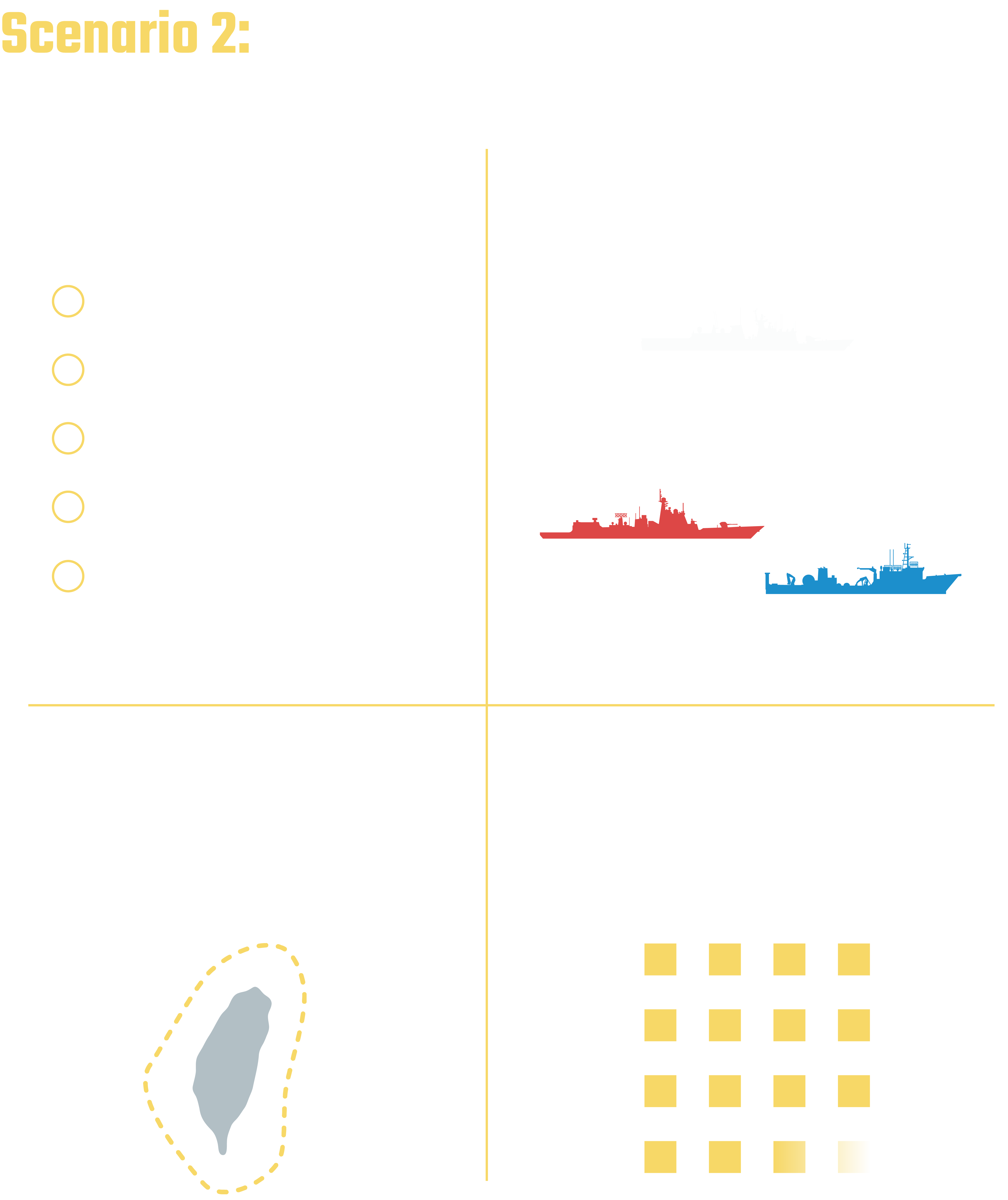Quarantine
Demo

Drawing on in-depth research, tabletop exercises, private consultations, and expert surveys, this report lays out China’s potential motivations for a quarantine and maps out two possible scenarios of how China could approach quarantine operations.
Why China Might Quarantine Taiwan
The term “quarantine” is sometimes used interchangeably with “blockade.” However, this report differentiates the two, defining a quarantine as a law enforcement–led operation to control maritime or air traffic within a specific area. A blockade would be a military-led campaign to significantly curtail the flow of traffic into Taiwan.
The purpose of a quarantine is not to completely seal Taiwan off from the world but to assert China’s control over Taiwan by setting the terms for traffic in and out of the island. A key goal is to compel countries and companies to comply with China’s terms. If foreign actors largely comply with the quarantine, it strengthens China’s narrative that it has control over Taiwan and undermines Taipei’s sovereignty claims.
A quarantine offers several potential advantages for China:
Limited in Scope
Unlike an invasion or blockade, a quarantine would not be seen as an act of war. It is also more reversible and would not require closing off the Taiwan Strait.
Feasible
Threats alone could compel most shipping companies to comply, meaning China may not have to interdict many shipping vessels to achieve desired effects.
Flexible
There are several approaches China could take. Successful implementation would set a precedent, making it easier to carry out additional operations in the future.
Difficult to Counter
A law enforcement–led gray zone operation complicates the ability of Taiwan, the United States, and other actors to respond.
This fourth point is crucial. In a recent survey of experts from the United States and Taiwan, the China Power Project found that experts were more skeptical of U.S. and allied willingness to intervene militarily in a quarantine than in a Chinese blockade or invasion of Taiwan. Only 13 percent of surveyed U.S. experts and 9 percent of Taiwan experts were “completely confident” that the United States would intervene militarily to defend Taiwan from a quarantine.
How China Could Implement a Quarantine
A quarantine would be an immense and unprecedented undertaking for China, requiring it to overcome complex logistics hurdles and jointly command law enforcement, military, and other forces. Nevertheless, China has immense capabilities at its disposal, and there are a range of approaches China could take.
Law enforcement would play the leading role. Chief among these forces would be the China Coast Guard (CCG), which would deploy its forces to patrol the waters around Taiwan and interdict vessels not complying with the quarantine. China’s Maritime Safety Administration (MSA), which is the primary civilian agency in charge of maritime security, could also deploy patrol ships alongside the coast guard.
Two other key forces would support these law enforcement vessels. First, China’s military can deploy naval, air, missile, cyber, and other forces to intimidate Taiwan, deter outside intervention, and provide crucial intelligence, surveillance, and reconnaissance (ISR). Second, China’s maritime militia could fill gaps in ISR and significantly complicate Taiwan’s operating environment.
Because China can employ a range of forces to lead the quarantine, it is challenging for other countries to respond to their activities. Taiwan’s coast guard possesses a fraction of the number of oceangoing ships in China’s coast guard fleet. Taiwan also lacks an equivalently large force to the maritime militia, meaning Taiwan would have to lean on its coast guard to respond to China’s militia activity.
With a wide range of forces at its disposal, China has great flexibility in how it approaches a quarantine.
China can scale up or down its deployment of forces based on the extent of compliance and other factors. If China can successfully compel most companies to cooperate through threats of fines or market access restrictions, it may not have to deploy additional forces. Conversely, if Taiwan responds strongly or other countries intervene, China could increase its own deployments as a countermove.
China can also choose what kind of traffic to target. It could focus on specific domains (e.g., maritime, air, or both), or be selective or encompassing in terms of the types of goods targeted. It can also significantly scale up or down the duration of the quarantine according to Beijing’s desired effect.
The scenarios outlined below are only two examples of potential maritime quarantines. There are many other conceivable approaches China could take. There are no publicly available Chinese doctrinal writings on how China could conduct a quarantine, but these scenarios align with operations and capabilities China has demonstrated through past activities.
Scenario 1
Limited Maritime Quarantine
In this first scenario, Beijing leverages its law enforcement forces to conduct a limited maritime quarantine focusing on one main port.
Days or weeks before the start of quarantine operations, China readies the CCG, MSA, and the military. It also calls up maritime militia fishing vessels in the area.
China begins by publicly announcing “enhanced customs inspection rules” that require all cargo and tanker vessels entering Taiwan to file advance customs declarations with relevant Chinese authorities. To minimize international pushback, China does not use terms like “quarantine” or “blockade” to describe its declared customs regime.
Chinese law enforcement vessels are authorized to board vessels, conduct on-site inspections, question personnel, and undertake other measures against noncompliant ships. Authorities threaten fines and market access restrictions for companies flouting the new rules.
The quarantine is set to enter into force 48 hours after announcement. This allows China time to deploy forces into position and provides shipping companies with vessels in transit warning time to comply with China’s new rules.
If China meets relatively limited pushback and most companies comply with Chinese customs rules, China begins to draw down operations after about one week. However, a considerable law enforcement and military presence persists around Taiwan in the weeks that follow—an indication of the new normal China has established.



Scenario 2
Full Maritime Quarantine
This scenario is a significantly scaled up version of the first scenario. Like in the first scenario, China declares new “enhanced customs inspection rules,” requiring companies to request authorization from Chinese authorities to enter Taiwan.
As the operation stretches into multiple days, Chinese ships and personnel need to be rotated. After the large initial deployment, China can fluctuate the number of forces depending on factors like capacity, the level of compliance with the quarantine, Beijing’s desired intensity, and U.S. and allied military posturing, if any.
These operations continue at varying levels for over two weeks before beginning to wind down. However, a significant CCG and PLA presence continues to operate indefinitely around Taiwan at a greater level than before the quarantine.



Conclusion
For both these scenarios, Beijing’s goal is not to hermetically seal Taiwan. Instead, these campaigns are designed to punish Taiwan, assert Beijing’s claimed sovereignty over the island, test the response from international shipping companies, and put significant pressure on Taiwan, the United States, and others.
While China has the capabilities to successfully execute these and other quarantine variations, these would require operations that are far more complex than anything China has demonstrated to date. Such moves would carry significant risk for China, and its success would depend to a large degree on how Taiwan, the United States, and others respond.
Even if successfully implemented, there are limits to what a quarantine can achieve. If Beijing’s goal is to inflict enough pain to force Taiwan’s surrender, China would need to move beyond the gray zone into overt military action. A military blockade would be a key option for China if it seeks to forcefully unify Taiwan without launching an all-out invasion.
For more detailed analysis, view the accompanying in-depth PDF report. Stay tuned for part two of this series, which will explore how China could blockade Taiwan.
This report was made possible by general support to CSIS.
Credits
Written by: Bonny Lin, Brian Hart, Matthew P. Funaiole, Samantha Lu, and Truly Tinsley
Special thanks to David S. Bury, John K. Culver, Lonnie Henley, Vern Huang, Isaac Kardon, Jennifer Kavanagh, Phillip C. Saunders, Joel Wuthnow, and Allen Yu for their detailed insights, and to all experts who participated in our tabletop exercises, workshops, and surveys.
Production by: Michael Kohler
Maps by: Mariel de la Garza, Lindsay Allison, José Romero, and Michael Kohler
Design support by: Fabio Murgia
Editorial by: Claire Smrt
Copyediting by: Katherine Stark
Video by: Jim Dyson
Getty Images/Footage: Feng Li, Chien Chih-Hung/Office of The President of Taiwan, CCTV+, Licet Studios, Bloomberg
